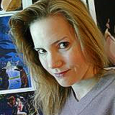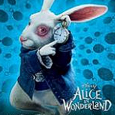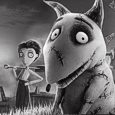Warner Brothers (September 16, 2005), Warner Home Video (January 31, 2006), single disc, 77 mins plus supplements, 1.85:1 anamorphic widescreen, Dolby Digital 5.1, Rated PG, Retail: $19.98
Storyboard:
A man freaked out by his impending marriage of convenience finds himself an alternate fiancé, who has many fine attributes. Among her faults, however, is that she is quite dead.
The Sweatbox Review:
Who could have seen it coming? When it was first announced that animated films would be receiving their own Academy Award category a few years ago, the talk at the time was how CGI films would dominate the nominees, as cel-animated filmmaking fell by the wayside. For release year 2005, however, there were no CGI films among the three Academy Award nominees for the 2006 ceremony. Instead, they included one cel-animated film from Japan, and two films using what some might call the rather antiquated form of stop-motion animation. It just goes to show what we have said all along— it’s not the medium that is important, it is the story and the execution.
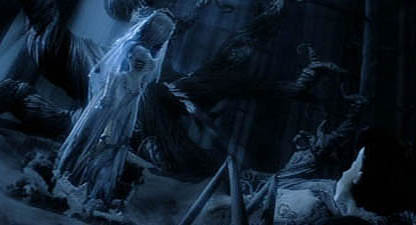
Tim Burton’s Corpse Bride has a strong pedigree, so its success should be no surprise. Corpse Bride director Tim Burton had conceived and produced 1993’s The Nightmare Before Christmas (directed by Henry Selick), which has become somewhat legendary as a masterpiece of stop-motion animation. I count myself among Nightmare’s fans, and tend to like anything that Burton directs, so I was quite keen to see Burton do the directing himself for Corpse Bride. (Mike Johnson, it must be noted, was the co-director.) And, while it may (barely) fail to reach the heights of Nightmare for various reasons, I still found Corpse Bride to be extremely well made and entertaining.
Burton’s first major foray into stop-motion animation came with his Disney featurette Vincent in 1982. It was just after completing Vincent that he wrote and illustrated a poem from which Corpse Bride later grew. The story was also related to ideas provided to Burton by the late Joe Ranft, a former Disney man who had worked with Burton on Nightmare before moving to Pixar. Ranft presented to Burton a story idea based on a Russian folktale. Burton developed the idea along with his writers over several years, waiting for the opportunity to make it into a stop-motion film. He wished to focus on the theme of love, contrasting it with beauty and other things that may only be skin deep. Burton decided to emphasize the fairy tale aspect, avoiding setting the story in a particular place. Still, he later chose to use a largely British cast, which reflected the theme of social classes in the final script; and the production design favored a look reflecting the region from which the folktale originated. The result is a movie with a Victorian outlook and an eastern European visual— sort of like an old horror movie, now that I think of it.
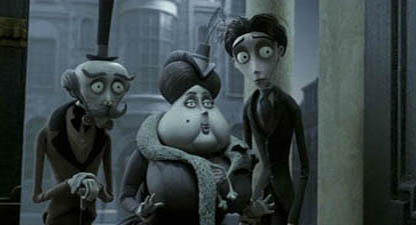
As I found out in the special features, there were technical advancements that assisted the directors and animators. The most interesting to me was that tiny gears were installed into the heads of the puppets that allowed the faces to change expression. This meant that the older method of changing heads between frames was no longer necessary. They also used a digital camera for photography, which allowed for instant feedback.
In a small 19th-century European village, two young people disparage at their plight, that of an arranged marriage. The girl’s ghastly parents, the Everglots, are aristocrats; but they are in fact financially near ruin. Desperate to regain some measure of wealth for themselves, they have agreed to have their daughter Victoria (Emily Watson) wed to the son of a wealthy fishmonger. The young man, Victor Van Dort (Johnny Depp), is just as nervous as his future bride, with neither looking forward to marrying a stranger. Victoria’s parents find the union between themselves and the nouveau riche utterly distasteful but necessary, while Victor’s parents see the marriage as their opportunity to gain acceptance with the upper classes.
Despite their anxiety, Victor and Victoria fall in love practically at first sight, with their nervousness now being sourced more from excitement than fear. Victor is especially nervous, and performs miserably at the wedding rehearsal. He rushes out of the church to compose himself, fleeing the mixture of disappointment and disgust of the observers inside. One man attending the rehearsal, however, is quite happy at the turn of events— Barkis Bittern is in fact oddly pleased.

Victor runs straight into the forest just outside the town. Once he collects himself, he rehearses his wedding vows. This time, he speaks perfectly. He even lends a bit of performance to his recitation, obviously having a much easier time releasing his charm to what he thinks is an absent audience. As he finishes the vows, he leans over to place the wedding ring onto a tree branch— which turns out to not be a branch at all. Instead, it is the hand of a girl who has lain in the ground for many years. She arises out of the earth wearing a wedding dress, looking both ghastly and beautiful. Naturally, Victor is quite freaked out, and he runs back towards the town. The corpse bride (Helena Bonham Carter) cuts him off, though, and Victor falls unconscious…
…and awakes in the Land of the Dead. Victor is totally disoriented, faced with the dead denizens of an afterlife bar. A skeleton named Bonejangles brings Victor up to speed on his new bride’s story, singing the tale of a young woman murdered just before her wedding day. Since then, she has waited for her true love to come for her; but now she has found a new love— a stranger who placed a ring upon her finger and has pledged his eternal love. Victor is frantic to point out how he was misunderstood, but to no avail. He flees again, going outside to find a “dead” world that is much more lively than what existed in his own town. He is found once again by the corpse bride, and he decides that he instead will have to play along in order to gain the opportunity to return to the Land of the Living.

He gets that chance, returning just long enough for a quick reunion with Victoria. The corpse bride catches up with him, though, and he is soon back in the Land of the Dead. Victor submits to a life with the corpse bride and even develops affection for her. Together, they decide to make their union official, but that will require another trip to the Land of the Living, where Victor must pursue his own death. Meanwhile, Victoria faces unpleasant nuptials of her own…
This summary would seem to give away much of the film, while making it sound morose and morbid, but the film is so much more than that. For one thing, I have left out probably two dozen memorable characters that populate the film, like the Peter Lorre-esque worm, or Peter Lee’s barking priest, or Alfred Gough’s wizened (and deceased) elder. Every character onscreen is a testament to great character design. From the pencil of Tim Burton to the hands of technicians and animators, everyone— every man, woman, corpse, and skeleton— has been created with a great sense of fun. Also, the tone of the film is actually sweet and sometimes electric, belying the idea that death needs to be depressing. No one makes movies like Tim Burton, and this film fits perfectly into his filmography. What sounds morose becomes celebratory, and repeatedly other conventional notions are challenged and turned on their head. Here, the living world is dour and colorless, overly concerned with class relationships and social standing; but the Land of the Dead is bright and cheery, with its citizens having nothing left to lose.
But to be honest, as much as I enjoyed the story, it could have been half as good and I would have still loved watching Corpse Bride. The animation here is spectacular. I have never seen such smooth stop-motion animation, and rarely has it been used to such good effect. The art direction naturally takes a huge cue from the drawings of Burton, but all of the designers and craftspeople need to be commended for creating such a distinct and interesting pair of worlds. The lighting is also amazing, helping greatly to make the worlds seem utterly real and believable. I literally sat with a grin on my face the whole time I was watching. It’s surprising I could follow the story at all, as swept up as I was by the visuals.

It’s hard to beat The Nightmare Before Christmas, a film so bursting with creativity that any comparison is really unfair. Corpse Bride stands on its own as a great little movie that challenges and delights the viewer in a way only Tim Burton can conceive.
Is This Thing Loaded?
All the extras, except for the trailer, are presented in the 4:3 screen ratio. There are a string of featurettes that should have just been edited together into a single “Making of” documentary, other than for the need to add bullets to the back of the DVD box.
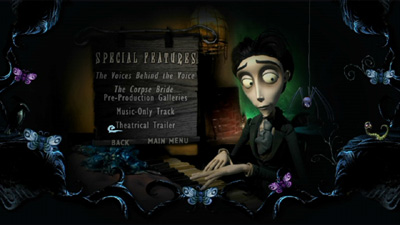
Inside The Two Worlds (4:03) is succinct but does a good job of letting the directors discuss how they envisioned the two worlds presented in the film. Danny Elfman Interprets The Two Worlds (4:56) looks at how Elfman scored the film, and offers some interesting information on his working methods that I had not heard before. The Animators: The Breath Of Life (6:38) takes an all-too-brief glimpse at how the film was animated, including the use of a digital camera for the photography; directors, animators, puppet builders, and designers all comment. Tim Burton: Dark Versus Light (3:39) has both the actors and the behind-the-scenes people comment on Burton’s vision. Voices From The Underworld (5:58) brings the voice actors back for more commentary, and the directors also share their thoughts on the actors. Making Puppets Tick (6:33) goes into the miniature gears that were created for facial expressions— just astonishing. There are also looks at animation tests and rigs used in the filming. Altogether, that makes about a half-hour of pretty good stuff, only diminished by being split up into so many small pieces.
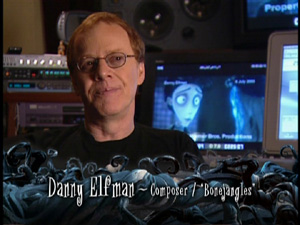
Additionally, there is Voices Behind The Voice (7:35), which offers split-screen footage of the actors alongside the final animation. I always dig that. The Corpse Bride Pre-Production Galleries (13:27) provides animation tests for many of the characters, as well as some storyboard-to-animation comparisons.
Elfman fans will be happy to see that the main feature can also be watched with a Music-Only Track, and the film’s Trailer (1:55) rounds out the special features.
Case Study:
While most copies come in a standard keepcase, there are exclusives in the US and Canada (Wal*Mart and Future Shop respectively), where one can find a special edition that includes a lenticular slipcase that holds both the keepcase and a very nice 100-page storybook with the story, lyrics, and additional information about the film. The cover of the slipcase is really quite cool, with the original one-sheet poster’s image (just like the regular DVD cover), except with a changing image that includes the bride switching between the two ladies in Victor’s life.
Ink And Paint:
The film is available in Widescreen and Fullscreen formats, available separately. I have the Widescreen version, which the package states is actually produced from matting the fullscreen version. Not having access to the fullscreen version, I cannot verify if this is correct (Warner has given out this label erroneously in the past, such as on it Justice League: Starcrossed DVD), but it likely is matted given how the film was photographed.

Regardless, I just loved how this DVD looked. Even the “drab” living world scenes pop vividly, while the “dead” world scenes are spectacular. Shadow detail is good— thankfully, since the scenes are generally dark. As the film was photographed digitally, it is possible that this is a digital-to-digital transfer; if it is from a print, then the print looks pristine. Warner’s people did a terrific job at the transfer, too, as I could see no artifacting.
Scratch Tracks:
Befitting a new release, the audio also sparkles. English, Quebec French, and Spanish all get 5.1 tracks. (Subtitles are also available in the same three languages.) Corpse Bride stacks up well against other new animated films, offering a fun aural experience with very active speakers all around the room. Danny Elfman’s typically kinetic score particularly benefits, but the sound effects are also all over the place— in a good way. Elfman’s songs are generally quite good as well, although to me not quite up to the delights he served up in The Nightmare Before Christmas. Close, though.
Final Cut:
This is a pretty nifty single disc, coming close to offering more bang for your buck than some overstuffed two-disc sets. The lack of a commentary is the only true disappointment, but the other features somewhat make up for it. The special features certainly could have gone further, but personally I’m grateful that I don’t feel I have to spend a week looking at each DVD I buy. The film itself is deserving of its Oscar nomination just on the basis of the great animation, even if the straight-forward (if playfully bizarre) story will likely allow another film to top it on Oscar night. With amazing stop-motion animation, creative design, and an oddly warm story, I highly recommend seeing this film, especially to Burton fans.
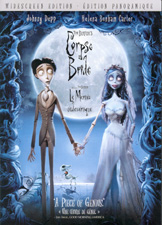 | ||
 |







